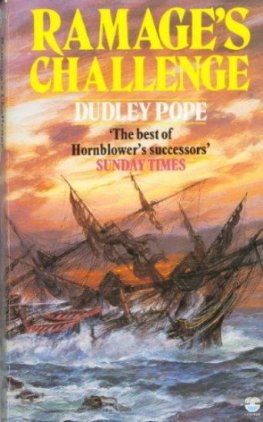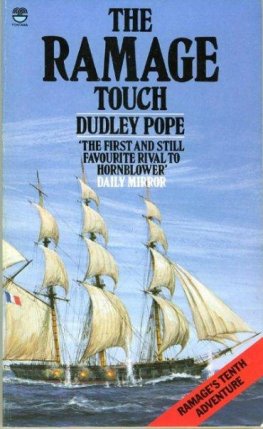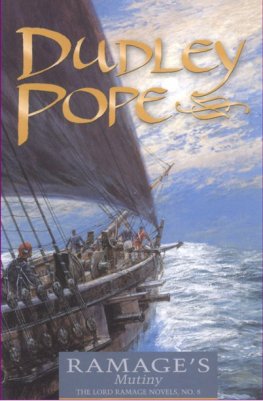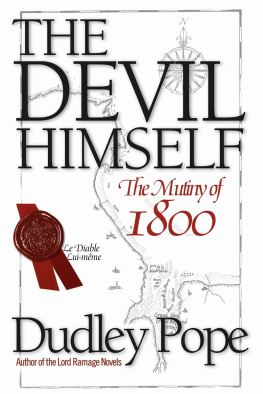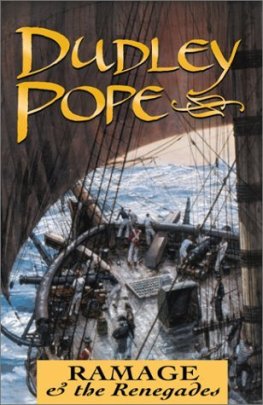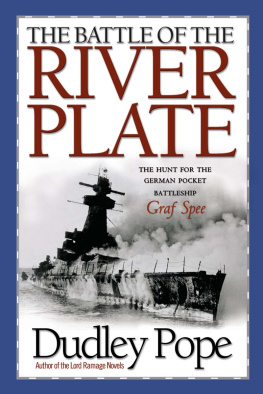DUDLEY POPE
Ramage's Challenge
(#15 in Ramage series)
For Kay
who crossed a rubicon
with me and sailed
past Cabo Trafalgar
in the moonlight.
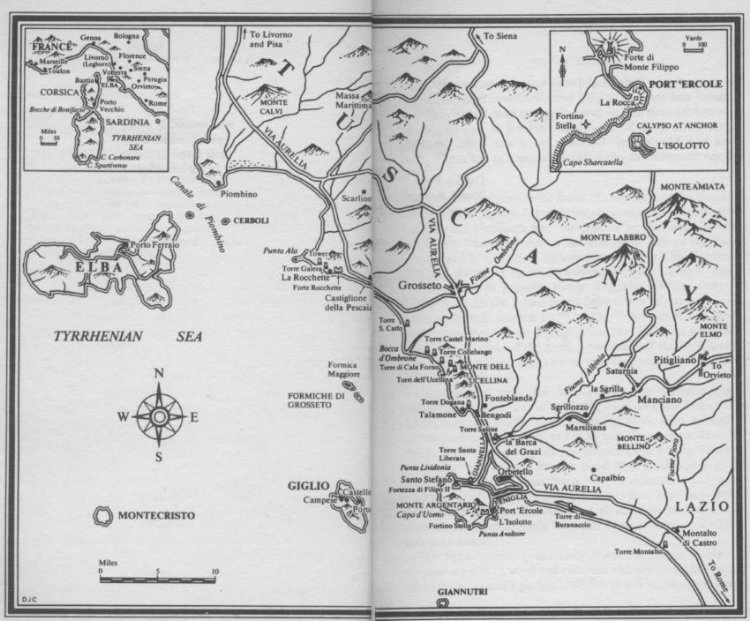
The Porto Santo Stefano of today was originally just "Santo Stefano" and there were only two causeways between Argentario and the mainland until the third was built to carry modern traffic. Forte della Stella was also known as Fortino Stella: Torri and Monte dell' Uccellina were also spelt Ucellina; Filippo Secundo was often Filipo Secundo at the time.
Dudley Pope
Yacht Ramage
French Antilles
The Atlantic entrance to the Strait of Gibraltar always reminded Ramage of a gigantic funnel lying on its side, its spout pointing towards the Mediterranean and forever replenishing the warm inland sea from the cold ocean. The lower side of the funnel was shaped by the North African coast between Casablanca and Tangier, the upper by the Spanish shore from Cadiz to Tarifa.
However, this present stretch of Spain reaching from off Cadiz down to the actual Strait (which was known to generations of British seamen as "The Gut") brewed the most unpredictable weather in Europe. No, that was not quite fair: perhaps the Texel, off the north-west corner of the Netherlands, was as bad: sudden and vicious thunderstorms spawned there too out of a clear sky.
Anyway, for once the wind taking the Calypso frigate diagonally across the Gulf of Cadiz, from off Faro down to the Strait, was remarkable only for its lightness: light enough to decide him to go in close to Cadiz and then stretch down towards The Gut, giving all his officers (and young Paolo in particular) a chance to have a good look at this part of the Spanish coast, which must be guarded by more forts and towers (one every half a dozen miles, it seemed) than anywhere he had ever seen except the Tuscan coast of Italy, which had coincidentally belonged to Spain for many years. Obviously the Dons favoured towers.
The light breezes (admittedly from the north, giving the Calypso a soldier's wind and calm sea and ensuring she was not off a lee shore) and a packet of sealed orders (to be opened once past Gibraltar) made him want to attack Cadiz just to placate his impatience.
He glared at Paolo. "Where did Columbus sail from on his third voyage?"
"Sanlcar de Barrameda at the southern end of those marshes, Las Marismas," the midshipman answered promptly. He pointed to the eastwards and added: "Just over there, sir."
"And Magellan?"
"Same place, sir."
"And where did the Spanish plate fleets arrive when they brought back the gold and silver from the Main?"
"Same place, sir, but they had to cross the bar and then sail or warp their way more than thirty miles up the River Guadalquivir to Seville, so that the bullion could be inspected by government men and officially weighed and stamped . . ."
Ramage nodded and pointed first at the chart spread on the top of the binnacle box and then at the shore running south-east five miles away over on the larboard side. "And where are we now?"
"Those low reddish cliffs have the Cortadura Fort at the northern end and the Torre Bermeja at the southern - you can just see the tower."
Ramage nodded and let his thoughts wander. He was looking at the coast of Andalusia. For more than a hundred years (beginning not so long after the Moors were driven out of Spain in 1492) an enormous quantity of gold and silver had poured into Spain from Mexico and Peru, yet a couple of centuries later Spain had nothing to show for it: no splendid palaces or new universities or even towns had been built with the money. No fleet, no army that mattered. The reason was simple enough: Philip II, who had sent the Armada against England (paying for it with the riches from the Spain Main), and the kings succeeding him, had spent money on armies intended to turn the Protestants of Europe into Catholics, particularly the Netherlanders.
When the navies of France and Britain, the buccaneers, pirates and the Dutch had managed to prevent the plate fleets reaching Sanlcar, the Spanish kings had borrowed heavily from the great bankers of Italy and Austria; the Fuggers and the Welsers, the Bardi and the Strozzi had been more than willing to lend - against the security of all the gold and silver of the Indies waiting on the Main to be shipped to Spain.
Then the king (he could not remember which one, but it was soon after Charles II was restored to the English throne) was trapped. His enemies' ships waited to catch the plate fleets at sea, so no bullion arrived in Spain, and with no bullion the king had no money to fit out the plate ships anyway.
Nor did he have the money to pay the bankers' interest on principal, so he defaulted on his debts. And that was how the Habsburgs broke the Fuggers, the enormously powerful family of merchant bankers which had (until it overextended itself with loans to Spain) financed wars, emperors and nations.
The Calypso's white-haired master, Edward Southwick, stood patiently to one side, recognizing the look on Ramage's face and waiting for him to come back from wherever his thoughts had led him.
He offered Ramage a telescope. "That round tower is the Torre del Puerco, sir, and you can just see the waves breaking on the off-lying reef, Banco de los Marrajos, which is a couple of miles to seaward."
Ramage swept the coast with the glass. "Then there are cliffs and a headland, a small one."
"That's right sir," Southwick said. "That's Cabo Roche, a good marker for the next reef, which is Lajas de Cabo Roche, three miles offshore."
Ramage walked to the ship's side and looked down at the water, and then aft at the Calypso's wake. "We're making about three knots and there doesn't seem to be much current."
"About a knot, southgoing," Southwick said, "but we can expect a couple of knots once we get a few miles past Cabo Trafalgar."
"Not often the current favours us," Ramage commented. He walked over and smoothed down the chart. "Hmm, I could just see the low reddish cliff beyond Cabo Roche. This is a good chart - where did you get it?"
"Bit o' luck," Southwick admitted. "My old one didn't have many details, but once I heard we'd be bound through The Gut, I saw an old friend o' mine who was the master of the flagship. I remembered he'd been along this coast several times, and he gave me a sight of the chart he'd drawn from three captured Spanish ones so I could copy it."
Ramage ran his finger along the coastline drawn in on the chart and beckoned to Paolo. "Medina Sidonia. What does that name mean to you?"
The young midshipman's brow wrinkled. "Accidente!" he exclaimed, lapsing into Italian. "An old Spanish family. That's all that comes to mind, sir."
Ramage pointed over the larboard bow. "That headland there, Cabo Roche . . ."
Paolo nodded.
"North of it you see a few hills, with the mountains behind. Then you come to that sugarloaf (which must be a thousand feet high) and if you had a glass you'd see a tower on top. That sugarloaf is called Medina Sidonia."
"Indeed, sir," Paolo said politely.
"But that sugarloaf is not the Medina Sidonia I'm referring to. Tell him, Southwick!"
The master grinned sympathetically. The captain often shot questions like this at Midshipman Orsini as part of his self-appointed task of educating the Marchesa di Volterra's nephew and heir.
"Philip II put the Duke of Medina Sidonia in command of the vast Armada he sent against England in 1588, but Drake and gales did for the poor old duke, who knew nothing of the sea and was a coward anyway," Southwick explained.

